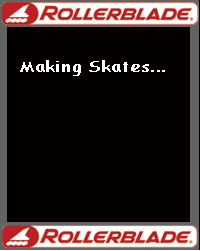 | |||||||||||||||||||||
 | |||||||||||||||||||||
| |||||||||||||||||||||
Skate Coach Kathy McSparran Friction and pressure are the two enemies of happy feet. Friction causes hot spots, which can progress to blisters. Pressure causes bruising, irritated toenails and sometimes more serious problems. What's the Rub? Friction is what you get when there's too much room inside your skates. The extra room allows your feet to slide around, which causes rubbing. If your skates are too big, the only solution may be to buy a new pair. But before you do that, try these less-expensive, and often effective, remedies: Save-a-Skate Tip Take a Powder Keep a few inexpensive makeup sponges in your fanny pack. As soon as you feel a hot spot developing, stick the sponge flat against the skin inside your sock. The sock will hold it in place, and the sponge will absorb most of the friction.
Don't Pressure Me! Save-a-Skate Tip Moleskin Donut Moleskin adhesive pads can be used to protect a small bruise or blister while it heals. Here's what you do:
The ideal boots fit snugly and apply equal pressure to all parts of your feet. But that's seldom the case with off-the-shelf skates. As a result, you may find that your skates concentrate excessive pressure on one (or more) spots on your foot, resulting in pain. Pressure points can be hard to fix. Try these remedies before rolling your skates into the trash:
Toe Trouble All sorts of problems arise if your boots don't provide enough room for your toes. Sometimes, there's not much you can do about it. But before you take out your credit card, try these fixes:
Ankles Away One common problem that is often easy to fix is bruising on the underside of the ankle bone. It is usually caused by a mismatch between the ankle pocket of your skate and your ankle. Elevating your foot with an extra or thicker footbed will often provide the right alignment. Bad Skater! Two bad habits that cause a lot of problems are pronating and supinating. Pronating is collapsing your ankles toward each other. Supinating is flopping them outward. Pronating tends to drive the cuff of your skate into your inner calf. Supinating does the opposite, pushing your cuff into your outer calf. Both positions can also cause your feet to slide sideways inside the skate, squashing your big or little toe. To correct this, sit down and position your ankles in a straight, non-collapsed position. (Use your eyes to check youself.) Once your feet are in the correct position, tighten your skates to give your ankles a little extra support. Then, as you skate, concentrate on keeping your ankles in this new straight alignment. Special note to pronators and supinators: Many beginners pronate simply because skating is new to them and they haven’t yet learned to keep their ankles straight. Often snug boots and a little practice corrects the problem.
However, a few skaters pronate (or supinate) because that's the way they're built. If you have found that the soles of your shoes wear more on the outside or inside edges, you may be one of these skaters. In that case, buy skates with laterally adjustable frames which can be positioned either to the inside or outside of your foot. That way you will be able to adjust your frames to counteract the cant of your ankles. Among the skates that allow this are Rollerblade's Crossfire/Activa 90 and 4D models or any of its Lightning models. Another thing that works is using some used wheels that are worn on one side only. If you are a pronator, turn the worn sides toward the outside of your feet. If you're a supinator, turn them toward the inside. Do you have your own "quick fixes" for skate fit problems? Share them at the Skate Coach Cafe. Related Reading:
...
Copyright © 2006 by Robert Burnson |
| ||||||||||||||||||||
Related Reading: | |||||||||||||||||||||
 | |||||||||||||||||||||



